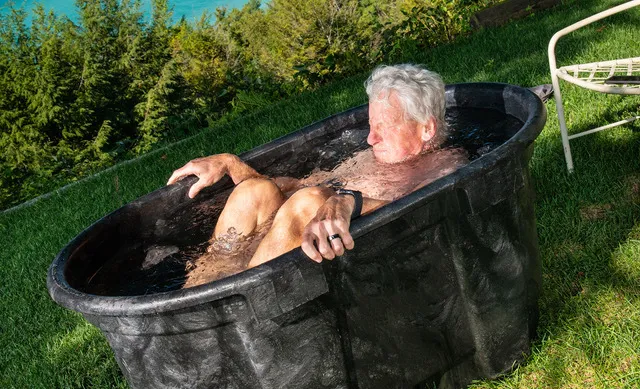.webp)
Breathing: The Most Efficient Way to Supercharge Your Conscious Leadership
Someone asked me the other day, “What’s the best bang for the buck when it comes to conscious leadership?” I love that question. My answer is breathing. If I think about the ratio of effort to impact, breathing wins the contest (most impact for the least effort).
But not just any kind of breathing. We all breathe all day, and we’re not all conscious all the time. The kind of breathing I mean involves intention and practice.
When I joined the Hendricks Institute apprentice program years ago, I was a breather but knew nothing about breathing. Fortunately for me, Gay Hendricks knew about breathing. It might be true that of all the brilliant things Gay has brought to the world, one of the most important is the value of breathing.
Over the years, I’ve used conscious breathing to move me from reactive to responsive, from below the line to above the line. Here are some tips and resources to help you do the same.
Note: I’m including links to many specific products, classes, and techniques. I don’t get any endorsement fee or reimbursement for recommending anything. I’ve never figured out how to have those kinds of arrangements and stay in complete integrity.
A Menu of Conscious Breath Types
I’ve explored various breath types or breath patterns for shifting my state of consciousness. I work with these techniques in two ways. First, I have used most of these breath practices in an ongoing way, as part of my morning routines, rituals, and hygiene. The other way I use them is on the fly, in the moment when I get triggered.
I highly recommend that you have one or two techniques that reliably work for you so that when you “fall off the wagon” of consciousness you know how to get back on.
4-7-8 Breathing: Dr. Andrew Weil makes a great case for 4-7-8 breathing, and several of my clients have found this to be their go to breathing technique when they hit the wall in life.
4 X 4 Breathing: This is what we at Conscious Leadership Group teach clients and teams. It’s so simple. Four seconds in. Four seconds out. Four times. It takes 32 seconds. Here’s a guided meditation I recorded some years ago leading you through this 4X4 breath.
The key is to breathe in through the nose, deep and down into the belly. You’ll know you’re inhaling correctly because if you put your hand on your naval you’d experience your hand moving in and out without using any muscles to move it. Then exhale for four seconds. For the exhale I prefer exhaling through the mouth.
A couple additions to the basic 4 X 4 breathing technique are to extend the exhale to six seconds, and to imagine on your exhale that you’re breathing out through a straw. Finally, try making sure that both your inhale and especially your exhale are full. Imagine on the exhale squeezing all the air out like squeezing a sponge dry.
Box Breathing: Made somewhat famous because we are told that Navy Seals use it to calm themselves, and anything that can work for Navy Seals in their stress-world could work for us in ours. Here’s an instruction video on how to practice box breathing. One caution about box breathing is that holding one’s breath can, at times, cause some panic and trigger a fight, flight, freeze reaction. This isn’t to say one shouldn’t use box breathing. But it’s good to pay attention to the effects of this and any other breathing technique on you and your experience.
Reset breath: Reset breath is another technique I learned from Gay Hendricks. With reset breath you take a full breath in and then breathe out, expunging all the breath. A key is to really squeeze out every bit of air you can. Imagine really contracting your belly at the naval to do this. Then, with all the breath out, hold as long as you can. That’s right, as long as you can. Most of us will start to get a signal from our bodies to breathe. As best you can, override that signal and a few of the subsequent ones until you HAVE to breathe. Then take a full breath in to fill your lungs. Exhale and return to normal breathing. I find reset breaths to be an instant energy infusion.
Bonus tip: Nose breathing at night. Finally, I’ve found the evidence for the value of nose breathing during sleep to be quite compelling. I’ve experimented with taping my mouth shut at night. I seem to breathe through my nose at night naturally, so I didn’t notice much difference, but others who have experimented with this have benefited greatly from retraining themselves.
Breath Training
For me, breath training includes conscious breathing, but goes further. It also trains the body and the nervous system. Gay Hendricks introduced me to breath training and for two years I spent 10-20 minutes a day training my body and breath. It changed me. I used a 4-week audio course called The Breathing Box and continue to this day to recommend it to many of my coaching clients.
Then about five years ago I learned about Wim Hof and did Wim Hof breathing most mornings for three years. I loved doing it and found it to be extremely supportive of my meditation practice, vitality, and stress management. I also combined breathing with cold exposure and found the combination to be a game-changer for me. I recommend the Wim Hof app and have also done several of his longer courses.
An aside about cold and heat exposure: I value Andrew Huberman’s podcasts as an introduction to the subject.(At an even more practical level, this is the cold tub I bought and I think it’s the best value for cold tubs. I spent a summer putting 40 lbs of ice in a 100-gallon Rubbermaid tank every day to make sure I would actually do cold exposure therapy, and then decided the investment in The Plunge was worth it for me.

Finally, on breath training, I want to mention resonance breathing and Dr. Lea Lagos. My caveat is that I have met Lea but never worked with her directly. A number of my clients have and for the most part they find the training deeply valuable; some would call it foundational to their continued success and competitive edge. Lea is a performance coach who works with breathing and heart-rate variability, among other things. You can learn about her work in her book, Heart Breath Mind.
Breath Journeys
The third category of my experience of breath and breathing involves what I’d call “breath journeys.” More and more we’re becoming familiar with medicine journeys where one takes a substance (MDMA, psilocybin, ayahuasca, ketamine, 5-MeO-DMT, etc.) and is guided into a healing or expanding experience for the sake of healing wounds and trauma and of expanding consciousness. Stanislav and Christina Grov developed Holotropic Breathing to allow us to use breathing to experience altered states of consciousness.
I’ve begun to use this method in the past four years or so and have found it profound, accessible, safe, and pretty easy. There are many resources available for those who would like an introduction to this powerful technique.
Further Resources
For those of you who like the science behind this I recommend Andrew Huberman’s podcast on breathing, “How to Breathe Correctly.”
I’ve also recently come across The Breathing App which is simple, elegant, flexible, and free.
If this subject of breathing interests you, you might enjoy James Nestor’s book, "Breath: The New Science of a Lost Art."
I'll end with one last recommendation. George Ramsey, a graduate of our coaches certification training program, is a passionate breather and trainer of breathing. He has a beautiful website with many, many breathing techniques and support structures. I highly recommend you visit it and familiarize yourself with all the support George is offering.









